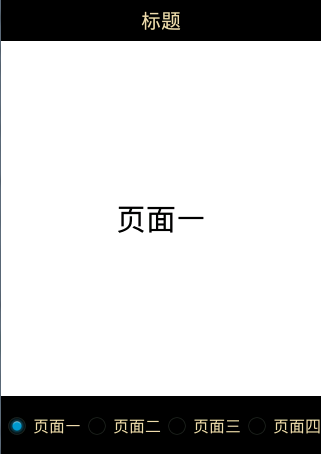简单的介绍一种Fragment+RadioGroup来搭建一下简单的页面架构
首先先看一下主界面的Activity代码
import android.os.Bundle;
import android.support.v4.app.Fragment;
import android.support.v4.app.FragmentActivity;
import android.support.v4.app.FragmentManager;
import android.support.v4.app.FragmentTransaction;
import android.view.View;
import android.view.View.OnClickListener;
import android.view.Window;
import android.widget.RadioButton;
import android.widget.RadioGroup;
import android.widget.Toast;
import com.example.fragmenttest.Fragment.FourFragment;
import com.example.fragmenttest.Fragment.OneFragment;
import com.example.fragmenttest.Fragment.ThreeFragment;
import com.example.fragmenttest.Fragment.TwoFragment;
public class MainActivity extends FragmentActivity implements OnClickListener {
/**
* Fragment 全是v4包
*/
private Fragment[] mFragments;
private FragmentManager manager;
private FragmentTransaction fragmentTransaction;
/**
* 初始化下部控件
*/
private RadioGroup rg;
private RadioButton radio1, radio2, radio3, radio4;
/**
* 上下文
*/
private FragmentActivity mContext;
@Override
protected void onCreate(Bundle savedInstanceState) {
super.onCreate(savedInstanceState);
requestWindowFeature(Window.FEATURE_NO_TITLE);
setContentView(R.layout.activity_main);
mContext = this;
// 初始化视图
initViews();
// 设置监听
setListener();
}
/**
* 初始化试图
*/
private void initViews() {
// 设置下部导航
rg = (RadioGroup) findViewById(R.id.rg);
radio1 = (RadioButton) findViewById(R.id.radio1);
radio2 = (RadioButton) findViewById(R.id.radio2);
radio3 = (RadioButton) findViewById(R.id.radio3);
radio4 = (RadioButton) findViewById(R.id.radio4);
// 设置Fragment
mFragments = new Fragment[4];
mFragments[0] = new OneFragment();// 页面一添加到集合中
mFragments[1] = new TwoFragment();// 页面二添加到集合中
mFragments[2] = new ThreeFragment();// 页面三添加到集合中
mFragments[3] = new FourFragment();// 页面四添加到集合中
manager = mContext.getSupportFragmentManager();// 获得FragmentManager
fragmentTransaction = manager.beginTransaction();// 获得事务
fragmentTransaction.add(R.id.fl, mFragments[0], mFragments[0] .getClass().getName());// 添加到FragmentLayout中
fragmentTransaction.add(R.id.fl, mFragments[1], mFragments[1] .getClass().getName());// 添加到FragmentLayout中
fragmentTransaction.add(R.id.fl, mFragments[2], mFragments[2] .getClass().getName());// 添加到FragmentLayout中
fragmentTransaction.add(R.id.fl, mFragments[3], mFragments[3] .getClass().getName());// 添加到FragmentLayout中
// 默认显示页面一,隐藏页面二
fragmentTransaction.show(mFragments[0]);
fragmentTransaction.hide(mFragments[1]);
fragmentTransaction.hide(mFragments[2]);
fragmentTransaction.hide(mFragments[3]);
fragmentTransaction.commitAllowingStateLoss();// 提交
}
/**
* 设置监听
*/
private void setListener() {
radio1.setOnClickListener(this);
radio2.setOnClickListener(this);
radio3.setOnClickListener(this);
radio4.setOnClickListener(this);
}
@Override
public void onClick(View view) {
FragmentTransaction transaction = mContext.getSupportFragmentManager() .beginTransaction();
switch (view.getId()) {
case R.id.radio1:
transaction.show(mFragments[0]);
transaction.hide(mFragments[1]).hide(mFragments[2]) .hide(mFragments[3]);
transaction.commitAllowingStateLoss();
Toast.makeText(mContext, "选择页面1", 0).show();
break;
case R.id.radio2:
transaction.show(mFragments[1]);
transaction.hide(mFragments[0]).hide(mFragments[2]) .hide(mFragments[3]);
transaction.commitAllowingStateLoss();
Toast.makeText(mContext, "选择页面2", 0).show();
break;
case R.id.radio3:
transaction.show(mFragments[2]);
transaction.hide(mFragments[0]).hide(mFragments[1]) .hide(mFragments[3]);
transaction.commitAllowingStateLoss();
Toast.makeText(mContext, "选择页面3", 0).show();
break;
case R.id.radio4:
transaction.show(mFragments[3]);
transaction.hide(mFragments[1]).hide(mFragments[2]) .hide(mFragments[0]);
transaction.commitAllowingStateLoss();
Toast.makeText(mContext, "选择页面4", 0).show();
break;
default:
break;
}
}
}1、管理Fragment
要在activity中管理fragment,需要使用FragmentManager. 通过调用activity的getFragmentManager()取得它的实例.
•可以通过FragmentManager做一些事情, 包括: 使用findFragmentById()(用于在activity layout中提供一个UI的fragment)或findFragmentByTag()(适用于有或没有UI的fragment)获取activity中存在的fragment。
2、处理Fragment事务
关于在activity中使用fragment的很强的一个特性是:根据用户的交互情况,对fragment进行添加、移除、替换以及执行其他动作。提交给activity的每一套变化被称为一个事务,可以使用在FragmentTransaction中的 API 处理。我们也可以保存每一个事务到一个activity管理的backstack,允许用户经由fragment的变化往回导航(类似于通过 activity往后导航)。
从 FragmentManager 获得一个FragmentTransaction实例:
每一个事务都是同时要执行的一套变化。可以在一个给定的事务中设置你想执行的所有变化,使用诸如 add()、remove()和 replace()。然后, 要给activity应用事务,必须调用 commit()。
3.add和replace的区别:
第一种添加,这种就好比我把几个Fragment添加到FragmentLayout中。然后根据我下面导航的点击监听,来让其页面显示和隐藏,执行效率高,不用再从新加载数据设置页面,
第二种替换,这种是让每次点击的时候都让页面重新替换到此页面,需要每次切换都需要联网请求数据来设置页面,
总结:两种模式在实际开放当中都有用到,具体用那个,需要看你的项目所要求的功能是怎样的.
下面是MainActivity.Xml
<LinearLayout xmlns:android="http://schemas.android.com/apk/res/android"
xmlns:tools="http://schemas.android.com/tools"
android:layout_width="match_parent"
android:layout_height="match_parent"
android:orientation="vertical" >
<TextView
android:layout_width="match_parent"
android:layout_height="40dp"
android:background="#000000"
android:gravity="center"
android:text="标题"
android:textColor="#EADAA9"
android:textSize="20sp" />
<FrameLayout
android:id="@+id/fl"
android:layout_width="match_parent"
android:layout_height="0dp"
android:layout_weight="0.7" >
</FrameLayout>
<RadioGroup
android:id="@+id/rg"
android:layout_width="match_parent"
android:layout_height="60dp"
android:background="#000000"
android:gravity="center"
android:orientation="horizontal" >
<RadioButton
android:id="@+id/radio1"
android:layout_width="wrap_content"
android:layout_height="wrap_content"
android:checked="true"
android:text="页面一"
android:textColor="#EADAA9" />
<RadioButton
android:id="@+id/radio2"
android:layout_width="wrap_content"
android:layout_height="wrap_content"
android:text="页面二"
android:textColor="#EADAA9" />
<RadioButton
android:id="@+id/radio3"
android:layout_width="wrap_content"
android:layout_height="wrap_content"
android:text="页面三"
android:textColor="#EADAA9" />
<RadioButton
android:id="@+id/radio4"
android:layout_width="wrap_content"
android:layout_height="wrap_content"
android:text="页面四"
android:textColor="#EADAA9" />
</RadioGroup>
</LinearLayout>最后写一个Fragment的代码
import android.os.Bundle;
import android.support.v4.app.Fragment;
import android.view.LayoutInflater;
import android.view.View;
import android.view.ViewGroup;
import com.example.fragmenttest.R;
/**
* 页面四
* @author admin
*
*/
public class FourFragment extends Fragment{
@Override
public void onCreate(Bundle savedInstanceState) {
super.onCreate(savedInstanceState);
}
@Override
public View onCreateView(LayoutInflater inflater, ViewGroup container,
Bundle savedInstanceState) {
return inflater.inflate(R.layout.fragment_four, container, false);
}
}
简单的架构已经成型了,随后我会再写 Fragment+FragmentTabHost实现仿新浪微博底部菜单栏 搭配使用的效果。























 4317
4317

 被折叠的 条评论
为什么被折叠?
被折叠的 条评论
为什么被折叠?








